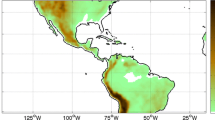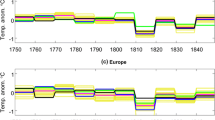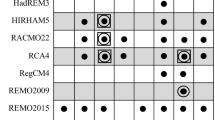Abstract
European surface temperatures have increased during the past decades. According to climate projections, this warming is expected to continue in future years under enhanced radiative forcings. In addition to the mean increase, changes in temperature variability are likely to occur, with more frequent extreme seasons such as those recently observed in the past decade (e.g. summer 2003, autumn 2006). Yet, most of the processes driving such long-term tendencies remain unidentified and unexplored. A particularly important issue is how changes in the atmospheric dynamics over the North-Atlantic and Europe (NAE) contribute to trends in both mean and extreme temperatures. The high occurrence of the positive phase of the North Atlantic Oscillation (NAO) in the 1980s–1990s suggested that the European warming could result from a re-organization in the main structures of the NAE dynamics. However, the 2000s have rather revealed an inconsistency between atmospheric circulation conditions and European temperatures. Here we investigate the relationship between sea-level pressure (SLP) and 2-m temperature (T2m) using a flow-analogues method applied over both observations and future projections. We use 13 models of the Third phase of the Coupled Model Intercomparison Project (CMIP3) over 1961–2000, 2046–2065 and 2081–2100, from which we extract seasonal subensembles with respect to their representation of observed SLP-T2m seasonal relationships. First we show that the distribution of SLP does not undergo major changes in future climate according to these seasonal model-ensembles, albeit a general decline of the variability is observed for all seasons. Then, using the flow-analogues, we conclude that the projected European warming appears disconnected from changes in the NAE dynamics. Only in winter a slight shift towards positive NAO conditions could partially contribute to the future temperature increase. Finally, a focus over unusually warm/cold seasons reveals that future temperature extremes should likely to be associated with similar atmospheric circulations as observed during recent ones.











Similar content being viewed by others
Notes
Models available at the IPSL database with both SLP and T2m daily outputs at the time of the study.
Using the smooth.splines function with spar = 0.4 in the R package (http://www.r-project.org).
In this paper, correlations between patterns or time series are called statistically significant when p value < 1%. However linear trends over a time period are called statistically significant when p value < 5%.
References
Beniston M (2007) Entering into the “greenhouse century”: recent record temperatures in switzerland are comparable to the upper temperature quantiles in a greenhouse climate. Geophys Res Lett rs 34(16):16710. doi:10.1029/2007GL030144
Beniston M, Diaz HF (2004) The 2003 heat wave as an example of summers in a greenhouse climate? Observations and climate model simulations for basel, switzerland. Global Planet Change 44(1–4):73–81
Beniston M, Stephenson DB, Christensen OB, Ferro CAT, Frei C, Goyette S, Halsnaes K, Holt T, Jylhä K, Koffi B et al (2007) Future extreme events in European climate: an exploration of regional climate model projections. Clim Change 81:71–95
Black E, Blackburn M, Harrison G, Hoskins B, Methven J (2004) Factors contributing to the summer 2003 European heatwave. Weather 59(8):217–223
Cassou C, Terray L, Phillips AS (2005) Tropical Atlantic influence on European heat waves. J Clim 18(15):2805–2811
Cattiaux J, Vautard R, Yiou P (2009) Origins of the extremely warm European fall of 2006. Geophys Res Lett 36(6):L06713. doi:10.1029/2009GL037339
Cattiaux J, Vautard R, Cassou C, Yiou P, Masson-Delmotte V, Codron F (2010a) Winter 2010 in Europe: a cold extreme in a warming climate. Geophys Res Lett 37:L20704. doi:10.1029/2010GL044613
Cattiaux J, Vautard R, Yiou P (2010b) North-Atlantic SST amplified recent wintertime European land temperature extremes and trends. Clim te Dyn 36(11–12):2113–2128. doi:10.1007/s00382-010-0869-0
Chase TN, Wolter K, Pielke Sr RA, Rasool I (2006) Was the 2003 European summer heat wave unusual in a global context. Geophys Res Lett 33(23):L23709. doi:10.1029/2006GL027470
Christensen JH, Hewitson B, Busuioc A, Chen A, Gao X, Held I, Jones R, Kolli RK, Kwon WT, Laprise R et al (2007) Climate change 2007: the physical science basis. Contribution of working group I to the fourth assessment report of the intergovernmental panel on climate change. Cambridge University Press, Cambridge
Corti S, Molteni F, Palmer TN (1999) Signature of recent climate change in frequencies of natural atmospheric circulation regimes. Nature 398(6730):799–802. doi:10.1038/19745
Delworth TL, Rosati A, Stouffer RJ, Dixon KW, Dunne J, Findell KL, Ginoux P, Gnanadesikan A, Gordon CT, Griffies SM et al (2006) GFDL’s CM2 global coupled climate models. Part I: Formulation and simulation characteristics. J Clim 19(5):643–674. doi:10.1175/JCLI3629.1
Fischer EM, Schär C (2009) Future changes in daily summer temperature variability: driving processes and role for temperature extremes. Clim Dyn 33(7):917–935
Gillett NP, Zwiers FW, Weaver AJ, Stott PA (2003) Detection of human influence on sea-level pressure. Nature 422(6929):292–294. doi:10.1038/nature01487
Giorgi F, Bi X (2005) Updated regional precipitation and temperature changes for the 21st century from ensembles of recent AOGCM simulations. Geophys Res Lett 32(21):L21715. doi:10.1029/2005GL024288
Gordon HB, Rotstayn LD, McGregor JL, Dix MR, Kowalczyk EA, O’Farrell SP, Waterman LJ, Hirst AC, Wilson SG, Collier MA et al. (2002) The CSIRO MK3 climate system model. Technical report 60, CSIRO Atmospheric Research, Aspendale
Goubanova K, Li L, Yiou P, Codron F (2010) Relation between large-scale circulation and European winter temperature: does it hold under warmer climate? J Clim 3752–3760. doi:10.1175/2010JCLI3166.1
Hasumi H, Emori S (2004) K-1 coupled model (MIROC) description. Center for Climate System Research, University of Tokyo, K-1 Technical report, vol 1, p 34
Hsu CJ, Zwiers F (2001) Climate change in recurrent regimes and modes of Northern Hemisphere atmospheric variability. J Geophys Res 106(D17):20145. doi:10.1029/2001JD900229
Hurrell JW (1995) Decadal trends in the North Atlantic Oscillation: regional temperatures and precipitation. Science 26:676–679
Hurrell JW, Kushnir Y, Ottersen G, Visbeck M (2003) The North Atlantic Oscillation: climatic significance and environmental impact. American Geophysical Union, Washington, DC
Jungclaus JH, Keenlyside N, Botzet M, Haak H, Luo J, Latif M, Marotzke J, Mikolajewicz U, Roeckner E (2006) Ocean circulation and tropical variability in the coupled model ECHAM5/MPI-OM. J Clim 19(16):3952–3972
Kim SJ, Flato G, Boer G, McFarlane N (2002) A coupled climate model simulation of the Last Glacial Maximum, Part 1: transient multi-decadal response. Clim Dyn 19(5):515–537. doi:10.1007/s00382-002-0243-y
Kjellström E, Bärring L, Jacob D, Jones R, Lenderink G, Schär C (2007) Modelling daily temperature extremes: recent climate and future changes over Europe. Clim Change 81(Suppl 1):249–265. doi:10.1007/s10584-006-9220-5
Lorenz EN (1969) Atmospheric predictability as revealed by naturally occurring analogues. J Atmos Sci 26(4):636–646
Luterbacher J, Dietrich D, Xoplaki E, Grosjean M, Wanner H (2004) European seasonal and annual temperature variability, trends, and extremes since 1500. Science 303(5663):1499–1503
Luterbacher J, Liniger MA, Menzel A, Estrella N, Della-Marta PM, Pfister C, Rutishauser T, Xoplaki E (2007) The exceptional European warmth of autumn 2006 and winter 2007: Historical context, the underlying dynamics and its phenological impacts. Geophys Res Lett 34:L12704. doi:10.1029/2007GL029951
Marti O, Braconnot P, Bellier J, Benshila R, Bony S, Brockmann P, Cadule P, Caubel A, Denvil S, Dufresne JL et al (2005) The new IPSL climate system model: IPSL-CM4. Note du Pôle de Modélisation 26:1288–1619
Meehl GA, Covey C, Delworth T, Latif M, McAvaney B, Mitchell JFB, Stouffer RJ, Taylor KE (2007) The WCRP CMIP3 multimodel dataset. Bull Am Meteorol Soc 88:1383–1394
Meehl GA, Stocker TF, Collins WD, Friedlingstein AT, Gaye AT, Gregory JM, Kitoh A, Knutti R, Murphy JM, Noda A et al (2007) Climate change 2007: the physical science basis. Contribution of working group I to the fourth assessment report of the intergovernmental panel on climate change. Cambridge University Press, Cambridge
Meehl GA, Tebaldi C (2004) More intense, more frequent, and longer lasting heat waves in the 21st century. Science 305(5686):994–997. doi:10.1126/science.1098704
Miller RL, Schmidt GA, Shindell DT (2006) Forced annular variations in the 20th century intergovernmental panel on climate change fourth assessment report models. J Geophys Res 111:D18101. doi:10.1029/2005JD006323
Min SK, Legutke S, Hense A, Kwon WT (2005) Internal variability in a 1000-yr control simulation with the coupled climate model ECHO-G–I. Near-surface temperature, precipitation and mean sea level pressure. Tellus A 57(4):605–621. doi:10.1111/j.1600-0870.2005.00133.x
Osborn TJ (2006) Recent variations in the winter North Atlantic Oscillation. Weather 61(12):63
Palmer TN (1999) A nonlinear dynamical perspective on climate prediction. J Clim 12:575–591
Philipp A, Della-Marta PM, Jacobeit J, Fereday DR, Jones PD, Moberg A, Wanner H (2007) Long-term variability of daily North Atlantic-European pressure patterns since 1850 classified by simulated annealing clustering. J Clim 20(16):4065–4095
Plaut G, Simonnet E (2001) Large-scale circulation classification, weather regimes, and local climate over France, the Alps and Western Europe. Clim Res 17(3):303–324
Randall DA, Wood RA, Bony S, Colman R, Fichefet T, Fyfe J, Kattsov V, Pitman A, Shukla J, Srinivasan J et al (2007) Climate change 2007: the physical science basis. Contribution of working group I to the fourth assessment report of the intergovernmental panel on climate change. Cambridge University Press, Cambridge
Rauthe M, Hense A, Paeth H (2004) A model intercomparison study of climate change-signals in extratropical circulation. Int J Climatol 24(5):643–662. doi:10.1002/joc.1025
Roeckner E, Arpe K, Bengtsson L, Christof M, Claussen M, Dümenil L, Esch M, Giorgetta M, Schlese U, Schulzweida U (1996) The atmospheric general circulation model ECHAM-4: model description and simulation of present-day climate. Max-Planck-Institut für Meteorologie, Hamburg, Report No.218, 90pp
Rust HW, Vrac M, Lengaigne M, Sultan B (2010) Quantifying differences in circulation patterns based on probabilistic models. J Clim (in press). doi:10.1175/2010JCLI3432.1
Salas-Mélia D, Chauvin F, Déqué M, Douville H, Gueremy JF, Marquet P, Planton S, Royer JF, Tyteca S (2005) Description and validation of the CNRM-CM3 global coupled model. CNRM working note 103
Scaife AA, Folland CK, Alexander LV, Moberg A, Knight JR (2007) European climate extremes and the North Atlantic Oscillation. J Clim 21(1):72–83
Schär C, Jendritzky G (2004) Hot news from summer 2003. Nature 432(7017):559–560
Schär C, Vidale PL, Luethi D, Frei C, Haeberli C, Liniger MA, Appenzeller C (2004) The role of increasing temperature variability in European summer heatwaves. Nature 427(6972):332–336. doi:10.1038/nature02300
Schmidt GA, Aleinov I, Bell N, Bauer M, Bauer S, Cairns B, Faluvegi G, Hu Y, Kiang NY, Koch D et al (2006) Present-day atmospheric simulations using giss modele: Comparison to in situ, satellite, and reanalysis data. J Clim 19(2):153–192. doi:10.1175/JCLI3612.1
Seneviratne SI, Corti T, Davin EL, Hirschi M, Jaeger EB, Lehner I, Orlowsky B, Teuling AJ (2010) Investigating soil moisture-climate interactions in a changing climate: a review. Earth Sci Rev 99:125–161
Shongwe ME, Graversen RG, van Oldenborgh GJ, van den Hurk BJJM, Doblas-Reyes FJ (2009) Energy budget of the extreme Autumn 2006 in Europe. Clim Dyn 1–12. doi:10.1007/s00382-009-0689-2
Slonosky VC, Yiou P (2001) The North Atlantic Oscillation and its relationship with near surface temperature. Geophys Res Lett 28:807–810
Stephenson DB, Pavan V, Collins M, Junge MM, Quadrelli R (2006) North Atlantic Oscillation response to transient greenhouse gas forcing and the impact on European winter climate: a CMIP2 multi-model assessment. Clim Dyn 27(4):401–420. doi:10.1007/s00382-006-0140-x
Tebaldi C, Hayhoe K, Arblaster JM, Meehl GA (2006) Going to the extremes. Clim Change 79(3):185–211. doi:10.1007/s10584-006-9051-4
Terray L, Demory ME, Déqué M, de Coetlogon G, Maisonnave E (2004) Simulation of late-twenty-first-century changes in wintertime atmospheric circulation over Europe due to anthropogenic causes. J Clim 17:4630–4635. doi:10.1175/JCLI-3244.1
Thompson DWJ, Wallace JM (2001) Regional climate impacts of the Northern Hemisphere annular mode. Science 293(5527):85
Trenberth KE, Jones PD, Ambenje P, Bojariu R, Easterling D, Klein-Tank A, Parker D, Rahimzadeh F, Renwick JA, Rusticucci M et al (2007) Climate change 2007: the physical science basis. Contribution of working group I to the fourth assessment report of the intergovernmental panel on climate change. Cambridge University Press, Cambridge
Uppala SM, Kallberg PW, Simmons AJ, Andrae U, da Costa Bechtold V, Fiorino M, Gibson JK, Haseler J, Hernandez A, Kelly GA et al (2005) The ERA-40 Reanalysis. Q J R Meteorol Soc 131:2961–3012. doi:10.1256/qj.04.176
van Oldenborgh GJ (2007) How unusual was autumn 2006 in Europe? Clim Past 3(3):659–668
van Ulden A, Lenderink G, van den Hurk B, van Meijgaard E (2007) Circulation statistics and climate change in Central Europe: prudence simulations and observations. Clim Change 81:179–192
van Ulden AP, van Oldenborgh GJ (2006) Large-scale atmospheric circulation biases and changes in global climate model simulations and their importance for climate change in Central Europe. Atmos Chem Phys 6:863–881
Vautard R, Yiou P (2009) Control of recent European surface climate change by atmospheric flow. Geophys Res Lett 36(22):L22702. doi:10.1029/2009GL040480
Walker GT (1924) Correlation in seasonal variation of weather, IX. Mem India Meteorol Depart 24(9):275–332
Wang C, Liu H, Lee SK (2010) The record-breaking cold temperatures during the winter of 2009/2010 in the Northern Hemisphere. Atmos Sci Lett. doi:10.1002/asl.278
Xoplaki E, Luterbacher J, Paeth H, Dietrich D, Steiner N, Grosjean M, Wanner H (2005) European spring and autumn temperature variability and change of extremes over the last half millennium. Geophys Res Lett 32:L15713. doi:10.1029/2005GL023424
Yiou P, Vautard R, Naveau P, Cassou C (2007) Inconsistency between atmospheric dynamics and temperatures during the exceptional 2006/2007 fall/winter and recent warming in Europe. Geophys Res Lett 34:L21808. doi:10.1029/2007GL031981
Yukimoto S, Noda A (2002) Improvements of the meteorological research institute global ocean-atmosphere coupled GCM (MRI-CGCM2) and its climate sensitivity. CGER’s Supercomput Activ Rep 10:37–44
Zampieri M, D’Andrea F, Vautard R, Ciais P, de Noblet-Ducoudré N, Yiou P (2009) Hot European summers and the role of soil moisture in the propagation of Mediterranean drought. J Clim 22:4747–4758. doi:10.1175/2009JCLI2568.1
Zorita E, Von Storch H (1999) The analog method as a simple statistical downscaling technique: comparison with more complicated methods. J Clim 12(8):2474–2489
Acknowledgments
We acknowledge the modeling groups, the Program for Climate Model Diagnosis and Intercomparison (PCMDI) and the WCRP’s Working Group on Coupled Modelling (WGCM) for their roles in making available the WCRP CMIP3 multi-model dataset. Support of this dataset is provided by the Office of Science, U.S. Department of Energy. We also would like to thank M. Lengaigne who performed the standardization processing from CMIP3 original dataset. This work was supported by the French ANR project CHEDAR (ANR-09-CEP-002).
Author information
Authors and Affiliations
Corresponding author
Rights and permissions
About this article
Cite this article
Cattiaux, J., Yiou, P. & Vautard, R. Dynamics of future seasonal temperature trends and extremes in Europe: a multi-model analysis from CMIP3. Clim Dyn 38, 1949–1964 (2012). https://doi.org/10.1007/s00382-011-1211-1
Received:
Accepted:
Published:
Issue Date:
DOI: https://doi.org/10.1007/s00382-011-1211-1




